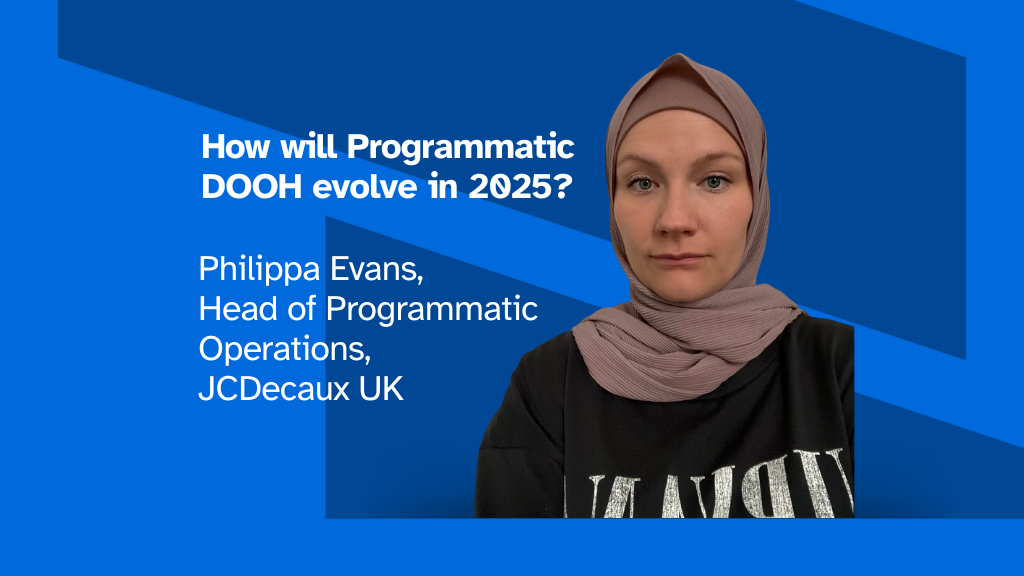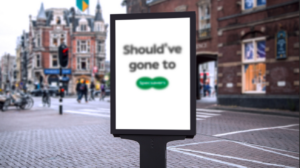By Philippa Evans, Head of Programmatic Operations, JCDecaux UK
Programmatic DOOH (pDOOH) is growing in popularity – case studies from brands including Lucozade, Maltesers, Dell, Costa, and IHG have helped to bolster awareness of the benefits of the channel, as well as spur innovation in planning, activation, and measurement. At JCDecaux, we believe that pDOOH will continue to advance and command a greater share of digital budgets in 2025, thanks to innovation in five key areas.
Smarter measurement
As reported in our research “A Tale of Evolution” marketers no longer see measurement as a significant challenge in pDOOH. Metrics such as brand awareness, sales, ROI, footfall, and performance uplift in other channels have routinely been used to measure performance over the past 12 months. However, as marketers become more comfortable with measuring pDOOH, they are starting to interrogate whether they are using the best KPIs to fairly evaluate the channel in an omnichannel context.
Incremental spend from digitally focused advertisers, and a rising awareness of pDOOH’s strengths throughout the funnel, are driving changes in measurement approaches. Greater emphasis is being placed on developing tools to measure reach, and upper-funnel metrics, that shed light on consumer behaviour after they have been exposed to pDOOH.
Additionally, brands and agencies are increasingly talking about the multiplier impact that outdoor has on other digital channels. Our own Two Screen Future research shows that exposure to any form of OOH advertising amplifies attention on private screens by 52%. I predict that in 2025 we’ll see more advertisers measuring the priming effect of pDOOH on omnichannel campaigns.
Consistently adding appropriate measurement to pDOOH campaigns helps agencies and DSPs to prove the value of the channel. Specific examples include how pDOOH can help overcome challenges and gaps in a media plan such as driving awareness, consideration, and sales or reaching niche audiences in a world where cookies are becoming less and less reliable.
Increased use of first-party data
Ensuring that media planning respects privacy regulations and data ethics, while maximising addressability and in-target reach, is a top priority for all brands and is driving a fresh approach to growing first-party data sets beyond growing consented email databases. For marketers investing in pDOOH this presents an opportunity to improve efficiency by integrating first-party data to optimise campaign spend, targeting, bids, and creative.
For example, retailers can use customer address data, IP signals, SDK data, web analytics, sales data, etc. to fuel their audience and creative strategies. Additionally, retail brands can create highly targeted campaigns that tap into the product preferences of audiences that over-index in certain locations, and at different times of the day. This essentially enables a brand to run multiple campaigns in the same location throughout the day, based on the type of consumers in the vicinity to their stores and outdoor panels
Given the dynamic nature of pDOOH, brands can also be extremely agile and update their creative, budget, and bid strategy based on their real-time pricing, time of day, footfall, product availability, trending products and dozens of other factors.
Seamless cross-channel experiences
Because pDOOH evolved alongside traditional OOH, the two routes to market are often combined, especially when campaigns are bought by specialist OOH agencies. On the flip side, programmatic specialists typically combine pDOOH with other programmatic channels (online video and display, mobile, CTV, audio), depending on what the brand is trying to achieve and what creative assets are available.
This separation of use cases has slowly ebbed over the past 12 months with more media plans emerging with traditional OOH and pDOOH combined alongside other programmatic channels all in the mix. Better measurement and insights from media mix modelling (MMM) are driving this trend, by providing more insights into the strongest and weakest synergies between channels, based on specific objectives.
Simultaneously, advances in technology are driving innovation in cross-channel experiences by providing buyers with ways to retarget consumers exposed to pDOOH with sequential messaging on other channels. Buyers can also adjust their channel mix to reach audiences that don’t respond well to online with pDOOH, to bolster performance.
As a result of this increased use of programmatic targeting across all channels, media craft will increase in importance as marketers look for ways to combat the staleness that can occur when everyone is using the same, or similar algorithms. In pDOOH, this comes down to getting to know the data that is available for campaign planning, delivery, and optimisation and working with media owners and demand-side platforms to better understand the unique insights they can provide.
Sustainability
Brands are increasingly concerned with sustainability and are actively integrating eco-friendly practices into media planning via in-house initiatives, agency tools, and third-party measurement providers. From 2025, businesses will face increasing ESG regulations led by the EU Corporate Sustainability Reporting Directive (CSRD). This will impose greater sustainability and carbon disclosure requirements on brands operating in the UK including on the media and advertising they buy.
Driven by this legislation, over the next 12 months we will see marketers’ attention shift from simply measuring environmental impact, to actively reducing it. This will mean that marketers will have to compare different channels and find a way to incorporate suitable criteria into holistic measurement.
In November this year, VIOOH, the leading premium global DOOH supply-side platform, announced its full year emissions intensity (an objective measure of carbon efficiency) for 2023, which was below 0.35 grams CO2e per ad impression. The results showed that pDOOH compares favourably vs initial industry benchmarks of 3.6g CO2e per impression for programmatic display, and 4.8g CO2e per impression for programmatic video. This means that pDOOH with VIOOH, is on average more than 10x carbon emission efficient compared with programmatic display, due to its broadcast nature and far less complex supply chain.
Artificial Intelligence
In a JCDecaux research project, the results of which will be published early in 2025, many participants cited the use of artificial intelligence (AI) as a key area of development in pDOOH. Three main use cases are emerging:
- The use of AI to provide advanced audience insights and analytics tools enabling marketers to gain a deeper understanding of consumer behaviours, preferences, and intent.
- Marketers are excited about using predictive analytics to help anticipate trends and customer actions and enable marketers to plan their media accordingly.
- Those with experience in pDOOH, are actively seeking AI solutions that can help design and optimise creative for maximum ‘in the moment’ engagement.
At JCDecaux, we have been building our own AI tools and partnering with System1 to ensure brands can optimise their creative to maximise attention and impact.
As we move into and through 2025, these trends in measurement, first-party data integration, omnichannel experiences, sustainability and innovations in AI will drive the growth of pDOOH. We expect to see an increase in the sophistication of targeting and creative strategies and for pDOOH to play a more integral part of digital advertising strategies.










